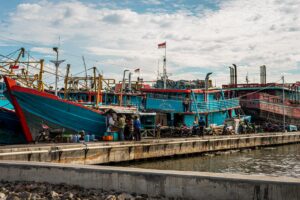Blog
Caught in Crime: Forced Labour and the Global Seafood Industry
Written by Megan Araghi
May 20, 2021
It is packed with vitamins and minerals, helps keep your bones strong and can prevent dementia in old age. Research from Queen Mary, University of London, show that seafood helps your heart healthy, which is associated with better cognitive abilities. There is just one catch: Recent investigations by media outlets and non-governmental organisations have documented extensive human trafficking and abusive labour practices on distant-water fishing vessels and seafood processing plants, particularly in East and Southeast Asia. China is one of the world’s most significant offenders, among Taiwan, South Korea, and Thailand. Many of these seafood products are sold to European and American markets. The US for example imports about 40% of Thailand’s total shrimp exports.
Seafood Slavery
Soas, University of London, is among those who have worked to put the issue of modern slavery on the international agenda. But while human trafficking in e.g. garment industry supply chains has received much attention in recent years, the fisheries sector has received less scrutiny. But this may be about to change. In a 2020 report, the United States Department of Labour was the latest to report on human trafficking and forced labour in the seafood supply chain.
Labour exploitation aboard the vessels is flagrantly abusive and inhumane, ranging from withholding workers’ identity documents, 18-22 hour work days with inadequate breaks, hunger, routine physical and verbal abuse, unsanitary accommodation, unsafe labour conditions, an inability to end their contracts or leave the vessel, and even executions as punishment for attempted escapes. Workers also frequently experience non or under-payment of wages and large debt burdens from necessities like food and high labour recruitment fees they will never be able to pay back. Victims in such conditions are held in what is known as debt bondage. According to the International Labour Organisation, a labourer is in debt bondage when they “…are forced to work for an employer in order to pay off their own debts or those they have inherited.”
Most people lured into forced labour in fisheries are labour migrants predominantly from Indonesia, the Philippines, Cambodia and Vietnam. There are reportedly tens of thousands of migrants in forced labour on Chinese-owned fishing vessels, for example.
Not unlike other human trafficking schemes, recruitment in fisheries often involves deceptive practices to lure vulnerable people across borders to offshore fishing vessels. Employment advertisements may appear legitimate, but provide false information about contract terms and wages, and force workers to pay excessive recruitment fees. Labour migrants on foreign vessels also have limited rights and access to legal recourse for abuse, making them even more vulnerable to exploitation.
Why Fisheries? Connecting the Dots
Why is the offshore fishing industry particularly prone to forced labour? There are three main reasons:
- A rise in demand for cheap seafood
- Overfishing
- A lack of effective regulation
The global rise in demand for cheap seafood has led to overfishing of legal fish stocks. In fact, it’s estimated that about one-third of the world’s supply is already overfished. Canned tuna, a critical export for many countries in the Global South, is the second most valuable seafood product in international trade, and in 2005 tuna fishing volumes reached 4.31 million tonnes for canned production.
This decrease in legal fish stock has led to a rapid rise in illegal, unreported, and unregulated fishing (IUU).
While a significant issue on its own, IUU is inextricably linked to human trafficking and labour exploitation in fisheries. As IUU depletes fish stocks near coastlines, commercial fishing vessels must travel further into unregulated international waters. This in turn increases a fleet’s fuel and labour costs. Trafficking desperate migrants to exploit their labour becomes an easy way for producers to cut costs. And with little to no oversight in the remote open ocean, the environment is ripe for labour abuse to go undetected for months or even years. Fishing vessels also may fly a “flag of convenience”, meaning the ship is registered in a country with weak enforcement of labour laws.
Challenges of Oversight
The solution may appear to be just a matter of creating traceability mechanisms. But the challenge is that the global seafood supply chain is a very complex, opaque web of producers, buyers, processors, etc. One catch of fish travels thousands of miles from where it was harvested to your plate, passing through many hands. This globalised nature and complicated structure of seafood supply chains makes it very difficult to implement effective oversight tools. During harvesting for example, smaller fishing vessels commonly transport their catch to a ‘mothership’ in exchange for fuel and supplies instead of returning to port, a practice known as transshipment. This isolates labour victims, and exploitation can remain undetected for long periods of time.
While some seafood traceability systems do exist, progress is limited and mostly focused on food safety, not addressing human rights abuses. Even though data on responsibly sourced seafood is scant, we as consumers can try to make the best decisions with what information is available. For example, consumers can shop at retailers selling seafood products certified by the Marine Stewardship Council or Best Practices Aquaculture. This guarantees the products have been harvested in both socially and environmentally responsible ways.
Just as ‘farm-to-table’ has become a staple phrase in our cultural vernacular, we must also ensure that ‘net-to-table’ is at the forefront of our awareness the next time we consume seafood.
Megan Araghi is a recent SOAS graduate in MSc Globalisation and Development and completed her thesis on responsible sourcing of cobalt from the Democratic Republic of Congo.
Photo by Tim Shepherd on Unsplash

